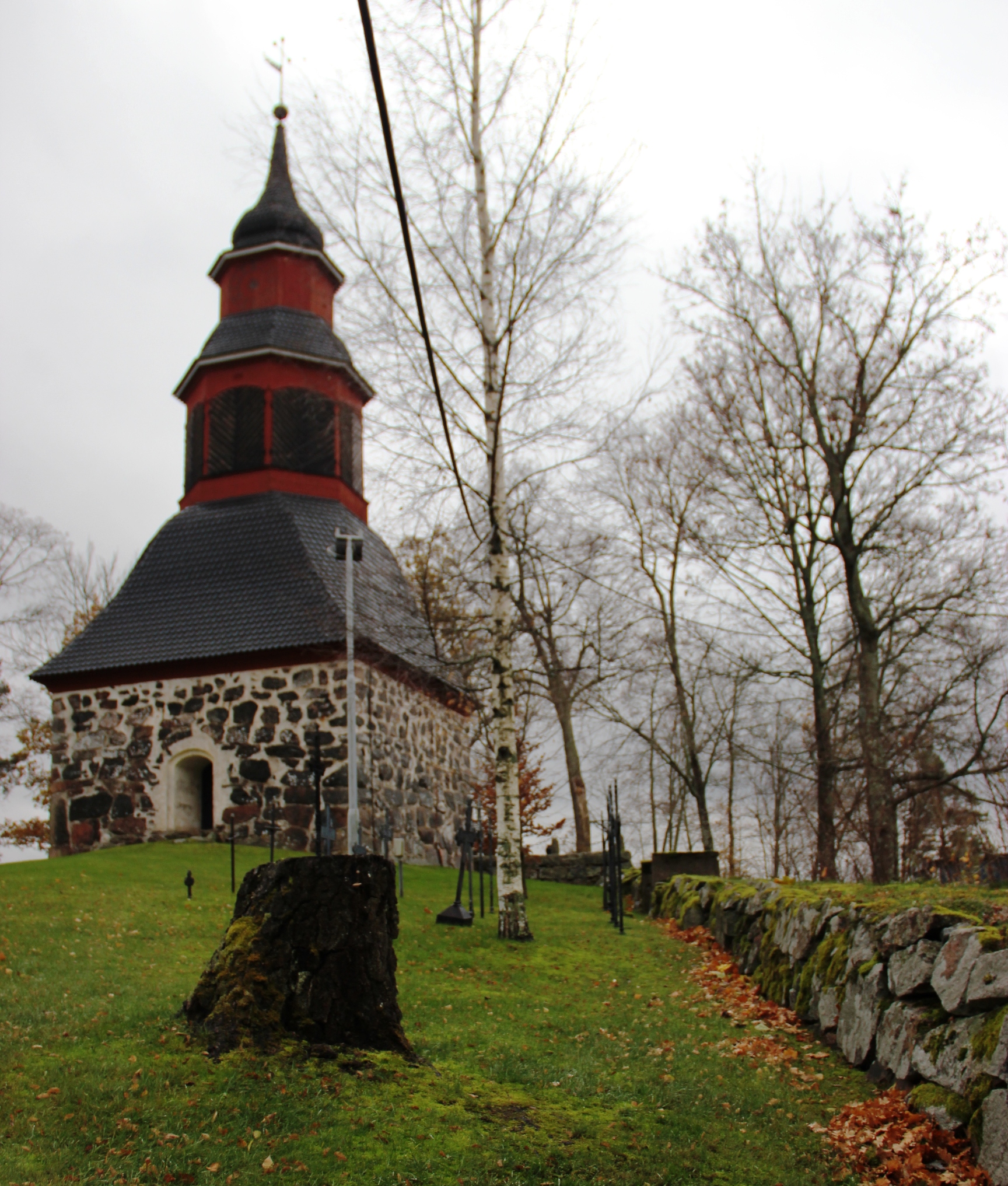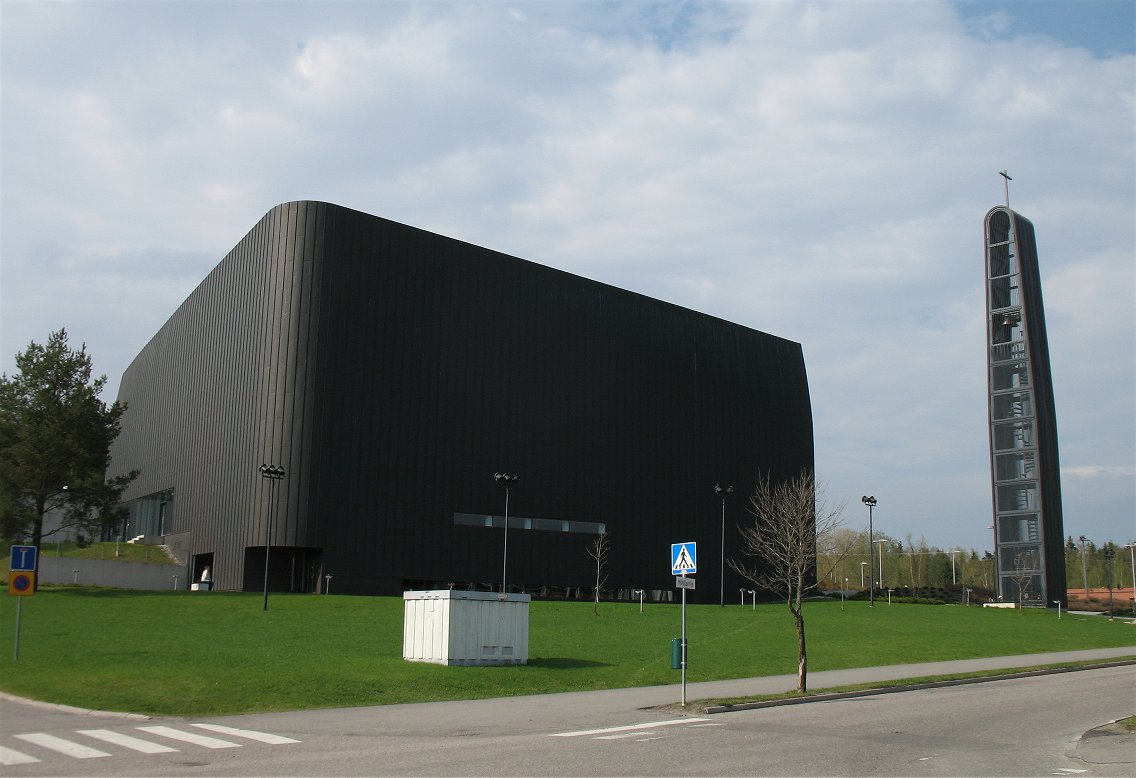|
Nurmijärvi Church
Nurmijärvi church ( fi, Nurmijärven kirkko, sv, Nurmijärvi kyrka) is a wooden church in Nurmijärvi, built in 1793. The church was built by Matti Åkerblom. The bell tower was completed in 1795 and was built by Mats Åkergren. The church is the fourth wooden church built in the Nurmijärvi village, the previous church built in 1692 was demolished in 1793. In 1776 King Gustav III ordered the churches to be built of stone. The lawns leaned on the parish of the church and were allowed to build a wooden church. At the end of the 18th century, the church was on the shore of the lake, but the " Kirkkojärvi" was drained in the 20th century. The Church is a transcendental cross church. There are bevels in the inner corner, and there are hallways at the end of the three bars. The ungodly shroud of the church has a roof razor. A lot of artefacts have been donated to the church, such as a candlestick, a candlestick and vases hanging on a central cross. Also stained glass has been dona ... [...More Info...] [...Related Items...] OR: [Wikipedia] [Google] [Baidu] |
Nurmijärvi
Nurmijärvi () is the most populated rural municipality of Finland, located north of the capital Helsinki. The neighboring municipalities of Nurmijärvi are Espoo, Vantaa, Tuusula, Hyvinkää and Vihti, and it is part of the Greater Helsinki. The population of the municipality is inhabitants. In recent decades, it has been one of the fastest growing municipalities in the Greater Helsinki and also in whole Finland in terms of population. The close proximity to Helsinki has led to a considerable growth of the major villages such as Klaukkala, Rajamäki and Röykkä. Klaukkala is the biggest built-up area of Nurmijärvi, which nowadays is considered a dormitory town of Helsinki. The Nurmijärvi church village (''Kirkonkylä'') is the administrative centre of the municipality, although the clear emphasis on population growth is in Klaukkala. Nurmijärvi literally means "lawn lake" although the lake that gave the municipality its name was drained in the early 20th century and is n ... [...More Info...] [...Related Items...] OR: [Wikipedia] [Google] [Baidu] |
1793
The French Republic introduced the French Revolutionary Calendar starting with the year I. Events January–June * January 7 – The Ebel riot occurs in Sweden. * January 9 – Jean-Pierre Blanchard becomes the first to fly in a gas balloon in the United States. * January 13 – Nicolas Jean Hugon de Bassville, a representative of Revolutionary France, is lynched by a mob in Rome. * January 21 – French Revolution: After being found guilty of treason by the French National Convention, ''Citizen Capet'', Louis XVI of France, is guillotined in Paris. * January 23 – Second Partition of Poland: The Russian Empire and the Kingdom of Prussia partition the Polish–Lithuanian Commonwealth. * February – In Manchester, Vermont, the wife of a captain falls ill, probably with tuberculosis. Some locals believe that the cause of her illness is that a demon vampire is sucking her blood. As a cure, Timothy Mead burns the heart of a deceased person in f ... [...More Info...] [...Related Items...] OR: [Wikipedia] [Google] [Baidu] |
Matti Åkerblom
Matti Åkerblom ( Pärnä; 18 July 1740, Eräjärvi — 10 June 1819, Orivesi) was a notable Finnish church designer and builder of the late 18th century, who also held the office of the regional master builder of the Province of Tavastia. Åkerblom first worked as a farm hand, but later decided to train as a carpenter, learning his trade under Antti Piimänen. His training took unusually long, with the apprenticeship and journeymanship stages each lasting five years, before he completed his master work, the bell tower of Halikko Church, in 1773. The master work had not been sanctioned by the guild, but when completed it was nevertheless approved, thus gaining Åkerblom his mastership. Notable churches built by Åkerblom include Nurmijärvi church, Pihlajavesi Old Church , native_name_lang = fi , image = Pihlajaveden-kirkko-2.jpg , image_size = , alt = , caption = Church pictured in 2007 , pushpi ... [...More Info...] [...Related Items...] OR: [Wikipedia] [Google] [Baidu] |
Nurmijärvi (village)
The Nurmijärvi church village (also known as Nurmijärvi; fi, Nurmijärven kirkonkylä) is the administrative center of the municipality by the same name in Uusimaa, Finland, with about 8,000 inhabitants. At the end of 2018, the population of the Nurmijärvi's urban area in accordance with Statistics Finland's agglomeration area was 7,429, made it the second most-populated urban area of the municipality. It is located from Rajamäki, from Röykkä and from the municipality's largest and the most-populated urban area, Klaukkala. The connecting road 1311 (former regional road 131) runs through the center between the Rajamäki and Hämeenlinnanväylä junctions. There is also a road connection to the center of Tuusula, as regional road 139 runs through the village of Palojoki towards Hyrylä. The largest industrial and business area in the municipality, Ilvesvuori, is being built near the center by the Tampere Highway ( E12), and a large logistics center owned by Kesko is ... [...More Info...] [...Related Items...] OR: [Wikipedia] [Google] [Baidu] |
Nurmijärvi (lake)
Nurmijärvi was a bird lake in Nurmijärvi municipality, in Finland. Its surface was first measured in the 1920s and it completely dried up in the 1950s. It was also called Kirkkojärvi (engl Engl or Engl. may refer to: *England, a country that is part of the United Kingdom * English * Engl (surname), a German surname *Engl., taxonomic abbreviation for botanist Adolf Engler Heinrich Gustav Adolf Engler (25 March 1844 – 10 October 1 ..., Churchlake). References Former lakes of Europe Nature of Nurmijärvi {{Finland-geo-stub ... [...More Info...] [...Related Items...] OR: [Wikipedia] [Google] [Baidu] |
Klaukkala Church
Klaukkala church ( fi, Klaukkalan kirkko, sv, Klövskogs kyrka) is a copper-plated modern church in Klaukkala of the Nurmijärvi municipality, built in 2004. The church was designed by Anssi Lassila; interior furniture and lamps were designed by interior architect Antti Paatero and liturgical textiles by Hanna Korvela. Mikko Heikka, a bishop of the Evangelic Lutheran Church, dedicated it on November 28, 2004. Construction claimed one death when a worker fell from the roof. Klaukkala Church was awarded the "Concrete of the Year" honorable mention in 2004. See also * Nurmijärvi church Nurmijärvi church ( fi, Nurmijärven kirkko, sv, Nurmijärvi kyrka) is a wooden church in Nurmijärvi, built in 1793. The church was built by Matti Åkerblom. The bell tower was completed in 1795 and was built by Mats Åkergren. The church is th ... References External links {{coord, 60.382778, 24.750833, display=title Lutheran churches in Finland Buildings of Nurmijärvi ... [...More Info...] [...Related Items...] OR: [Wikipedia] [Google] [Baidu] |
Rajamäki Church
Rajamäki may refer to: Place *Rajamäki (village), Finland Surname * Antti Rajamäki (born 1952), Finnish sprinter *Kari Rajamäki (born 1948), Finnish politician *Marko Rajamäki Marko Rajamäki (born 3 October 1968) is a Swedish-born Finnish former footballer and current manager of TPS. He managed Turun Palloseura between 2010 and 2014. Previously he managed the club's under-18 team (since 2002) and was also the assis ... (born 1968), Finnish football manager * Susanna Rajamäki (born 1979), Finnish athlete {{disambiguation ... [...More Info...] [...Related Items...] OR: [Wikipedia] [Google] [Baidu] |
Lutheran Churches In Finland
Lutheranism is one of the largest branches of Protestantism, identifying primarily with the theology of Martin Luther, the 16th-century German monk and reformer whose efforts to reform the theology and practice of the Catholic Church launched the Protestant Reformation. The reaction of the government and church authorities to the international spread of his writings, beginning with the ''Ninety-five Theses'', divided Western Christianity. During the Reformation, Lutheranism became the state religion of numerous states of northern Europe, especially in northern Germany, Scandinavia and the then-Livonian Order. Lutheran clergy became civil servants and the Lutheran churches became part of the state. The split between the Lutherans and the Roman Catholics was made public and clear with the 1521 Edict of Worms: the edicts of the Diet condemned Luther and officially banned citizens of the Holy Roman Empire from defending or propagating his ideas, subjecting advocates of Lutheranism ... [...More Info...] [...Related Items...] OR: [Wikipedia] [Google] [Baidu] |
_beach.jpg)



.jpg)